Down-regulation of B cell receptor signaling by hematopoietic progenitor kinase 1 (HPK1)-mediated phosphorylation and ubiquitination of activated B cell linker protein (BLNK)
- PMID: 22334673
- PMCID: PMC3322877
- DOI: 10.1074/jbc.M111.310946
Down-regulation of B cell receptor signaling by hematopoietic progenitor kinase 1 (HPK1)-mediated phosphorylation and ubiquitination of activated B cell linker protein (BLNK)
Abstract
Hematopoietic progenitor kinase 1 (HPK1) is a Ste20-like serine/threonine kinase that suppresses immune responses and autoimmunity. B cell receptor (BCR) signaling activates HPK1 by inducing BLNK/HPK1 interaction. Whether HPK1 can reciprocally regulate BLNK during BCR signaling is unknown. Here, we show that HPK1-deficient B cells display hyper-proliferation and hyper-activation of IκB kinase and MAPKs (ERK, p38, and JNK) upon the ligation of BCR. HPK1 attenuates BCR-induced cell activation via inducing BLNK threonine 152 phosphorylation, which mediates BLNK/14-3-3 binding. Furthermore, threonine 152-phosphorylated BLNK is ubiquitinated at lysine residues 37, 38, and 42, leading to attenuation of MAPK and IκB kinase activation in B cells during BCR signaling. These results reveal a novel negative feedback regulation of BCR signaling by HPK1-mediated phosphorylation, ubiquitination, and subsequent degradation of the activated BLNK.
Figures

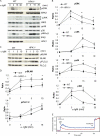
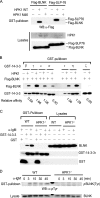

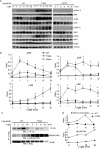
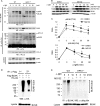
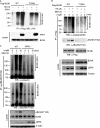
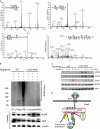
Similar articles
-
B cell adaptor containing src homology 2 domain (BASH) links B cell receptor signaling to the activation of hematopoietic progenitor kinase 1.J Exp Med. 2001 Aug 20;194(4):529-39. doi: 10.1084/jem.194.4.529. J Exp Med. 2001. PMID: 11514608 Free PMC article.
-
Attenuation of T cell receptor signaling by serine phosphorylation-mediated lysine 30 ubiquitination of SLP-76 protein.J Biol Chem. 2012 Oct 5;287(41):34091-100. doi: 10.1074/jbc.M112.371062. Epub 2012 Aug 17. J Biol Chem. 2012. PMID: 22902619 Free PMC article.
-
Hematopoietic progenitor kinase 1 associates physically and functionally with the adaptor proteins B cell linker protein and SLP-76 in lymphocytes.J Biol Chem. 2001 Nov 30;276(48):45207-16. doi: 10.1074/jbc.M106811200. Epub 2001 Aug 3. J Biol Chem. 2001. PMID: 11487585
-
MAP4K Family Kinases in Immunity and Inflammation.Adv Immunol. 2016;129:277-314. doi: 10.1016/bs.ai.2015.09.006. Epub 2015 Oct 26. Adv Immunol. 2016. PMID: 26791862 Review.
-
Interactions between hematopoietic progenitor kinase 1 and its adaptor proteins (Review).Mol Med Rep. 2017 Nov;16(5):6472-6482. doi: 10.3892/mmr.2017.7494. Epub 2017 Sep 13. Mol Med Rep. 2017. PMID: 28901492 Review.
Cited by
-
Deficiency in VHR/DUSP3, a suppressor of focal adhesion kinase, reveals its role in regulating cell adhesion and migration.Oncogene. 2017 Nov 23;36(47):6509-6517. doi: 10.1038/onc.2017.255. Epub 2017 Jul 31. Oncogene. 2017. PMID: 28759036
-
MAP4K3/GLK in autoimmune disease, cancer and aging.J Biomed Sci. 2019 Oct 22;26(1):82. doi: 10.1186/s12929-019-0570-5. J Biomed Sci. 2019. PMID: 31640697 Free PMC article. Review.
-
The immunomodulatory functions and molecular mechanism of a new bursal heptapeptide (BP7) in immune responses and immature B cells.Vet Res. 2019 Sep 18;50(1):64. doi: 10.1186/s13567-019-0682-7. Vet Res. 2019. PMID: 31533803 Free PMC article.
-
Identification of molecular glues of the SLP76/14-3-3 protein-protein interaction.RSC Med Chem. 2021 Aug 2;12(9):1555-1564. doi: 10.1039/d1md00172h. eCollection 2021 Sep 23. RSC Med Chem. 2021. PMID: 34667951 Free PMC article.
-
Terminating B cell receptor signaling.Oncotarget. 2017 Dec 6;8(66):109857-109858. doi: 10.18632/oncotarget.22986. eCollection 2017 Dec 15. Oncotarget. 2017. PMID: 29299112 Free PMC article. No abstract available.
References
-
- Yanaba K., Bouaziz J. D., Matsushita T., Magro C. M., St Clair E. W., Tedder T. F. (2008) B-lymphocyte contributions to human autoimmune disease. Immunol. Rev. 223, 284–299 - PubMed
-
- Townsend M. J., Monroe J. G., Chan A. C. (2010) B-cell targeted therapies in human autoimmune diseases: an updated perspective. Immunol. Rev. 237, 264–283 - PubMed
-
- Koretzky G. A., Abtahian F., Silverman M. A. (2006) SLP76 and SLP65. Complex regulation of signaling in lymphocytes and beyond. Nat. Rev. Immunol. 6, 67–78 - PubMed
-
- Datta S. R., Katsov A., Hu L., Petros A., Fesik S. W., Yaffe M. B., Greenberg M. E. (2000) 14-3-3 proteins and survival kinases cooperate to inactivate BAD by BH3 domain phosphorylation. Mol. Cell 6, 41–51 - PubMed
-
- Jang I. K., Zhang J., Gu H. (2009) Grb2, a simple adapter with complex roles in lymphocyte development, function, and signaling. Immunol. Rev. 232, 150–159 - PubMed
Publication types
MeSH terms
Substances
Grants and funding
LinkOut - more resources
Full Text Sources
Other Literature Sources
Molecular Biology Databases
Research Materials
Miscellaneous

